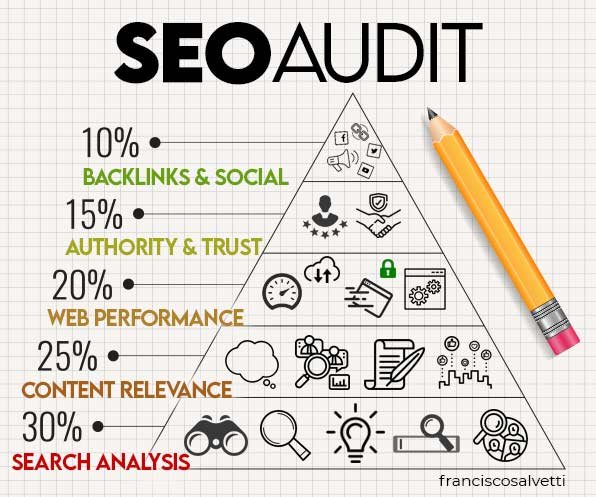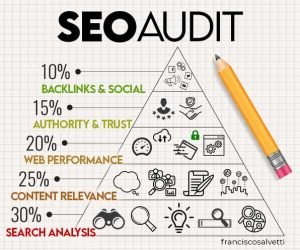Maintaining a robust online presence has never been more crucial for businesses looking for sustainable growth. In such a scenario, businesses have to rely on search engine optimization (SEO) to build a discoverable and reputable presence in the online ecosystem. However, implementing the best SEO practices is barely adequate. Businesses need to conduct enterprise SEO audits to ensure the overall effectiveness of the SEO strategy and its outcomes on the website’s performance.
Enterprise SEO audit considers several technical & non-technical aspects of a website’s SEO strategy, including content quality & relevance, keyword optimization, site structure, content quality, backlinks, navigability, optimization opportunities, and more. As a result, the process is lengthy and can get a little complex without the right guidance or experience. You can either take expert assistance from professional SEO services or conduct the audit yourself.
In this comprehensive content marketing guide, we’ll walk you through a 10-point checklist to conduct a thorough enterprise SEO audit that will help you enhance your website’s visibility and drive organic traffic, all by yourself!
Keyword Research and Analysis
Identifying relevant keywords related to business goals and those used by competitors is the groundwork of an effective SEO strategy. So, start your enterprise SEO audit by conducting keyword research and analysis. Pinpoint the primary and long-tailed keywords that define your brand, products, and services the best. You can use keyword research tools like Google Keyword Planner, Ahrefs, and SEMrush to conduct in-depth keyword research and discover high-value keywords that can attract organic visitors through search engines.
Once you have your keyword list, analyze the competition for each keyword. Determine the difficulty of ranking for these keywords and check whether they match your business goals, products, or services. Additionally, assess the search intent behind these keywords to ensure your content matches the user’s query.
On-Page SEO Optimization
Next, delve into your website’s on-page SEO elements to conduct an enterprise SEO audit. This involves taking individual pages from your website and analyzing whether it meets the target SEO performance. The analysis should be followed by optimization to make sure that even the individual pages are search-engine friendly. To analyze and optimize, review the following aspects:
- Title Tags: Each page should have a unique & interesting title tag with relevant keywords.
- Meta Descriptions: Sell your content to SERP viewers with compelling and keyword-optimized meta descriptions.
- Header Tags: Use H1, H2, and H3 tags to make your content more defined, structured, and readable.
- URL Structure: Optimize your URLs for user-friendliness and include keywords where appropriate.
- Content Quality: Review the content on your pages to ensure it is high-quality, relevant, and valuable to your audience.
- Internal Linking: Use hyperlinks & CTAs strategically within your individual web pages to internally link your content on related topics.
- Image Optimization: Make sure that images used are of high quality, compressed, and optimized with keyword-rich file names and alt texts.
Technical SEO Audit
An enterprise SEO audit would remain incomplete without an in-depth technical SEO audit. Conducting an SEO audit primarily focused on the technical aspects will ensure your website functions optimally and ranks well in search engines. Review the following technical aspects of your site:
- Site Speed: Determine if your website’s loading speed is up to the mark. A faster loading speed for a website will ensure a better and more seamless user experience, paving the way for higher rankings.
- Mobile Optimization: The majority of internet users access websites through mobile phones. This is why Google pays significant importance to mobile responsiveness while indexing web pages. Make sure your website is mobile-friendly, easy to navigate, and responsive.
- Crawlability: Ensure search engine bots can crawl and index your site. You can use tools like Google Search Console to pinpoint crawling issues and address them more proactively, elevating rankings and user experience.
- XML Sitemap: Create and submit an XML sitemap to allow search engines to map out your site architecture for seamless navigation and boost your visibility.
- Robots.txt File: Review and optimize your robots.txt file to ensure that the search engine bots are crawling only relevant content on your website for better indexing.
- HTTPS: Make sure your website has an SSL certificate to demonstrate that it is secure to visit. This will build trust among your potential audience and elevate rankings.
Technical SEO guides can help you identify and locate more opportunities for technical SEO audits.
Backlink Profile Analysis
Backlinks are crucial to establish the authority and credibility of your website and improve search engine rankings. Hence, examining your backlink profile is a crucial step of an enterprise SEO audit process. You can use backlink guides to understand the scope of backlinks on the overall performance of your website. Anyhow, utilizing specialized tools like Ahrefs, Majestic, or SEMrush can help you expedite the process by providing insights on:
- Domain Authority: Assess the authority of websites linking to your site and aim for high-quality backlinks from authoritative sources.
- Toxic Links: Identify and disavow toxic or spammy backlinks that can harm your website’s reputation.
- Anchor Text Distribution: Review the anchor text of your backlinks and ensure it appears natural and diverse.
Content Audit
A well-organized and valuable content strategy is essential for SEO success. Conducting an in-depth content analysis to assess the overall quality and relevance of your existing can have a long-lasting impact on your enterprise SEO audit outcomes. Evaluate which topics are covered well, and which remain to be covered, check keyword density and relevance, and ensure that the content format aligns with the best practices guidelines. Elevate the efficiency & effectiveness of content audit with the following steps:
- Identify Thin Content: Locate pages with low word counts or poor-quality content and either improve or remove them.
- Duplicate Content: Check for duplicate content issues and implement canonical tags or redirects to resolve them.
- Keyword Integration: Ensure your target keywords are placed strategically within your content.
- Content Gaps: Identify topics or keywords not adequately covered on your website and plan new content accordingly.
- Content Promotion: Make sure that your high-quality content reaches the right audience by promoting it on different social media channels and through email marketing.
User Experience Analysis
A positive user experience is crucial for determining the success of your website. Evaluate the following aspects of user experience when you are conducting an enterprise SEO audit:
- Mobile Responsiveness: Ensure your site is mobile-friendly and responsive for all devices.
- Page Layout: Assess the layout of your pages to guarantee a clear and logical structure.
- Website Navigation: Optimize your site’s navigation for easy access to important pages.
- Page Load Speed: Monitor page load times and work on optimizing them.
- Call-to-Action (CTA): Review and optimize your CTA placement and design to guide users toward desired actions.
Local SEO Analysis
If your business has a physical location or a local presence, then you may want to reach potential customers in and around your physical locality. To ensure this, you must use local SEO. Conduct a local SEO audit as a part of your enterprise SEO audit process to enhance your visibility in local search results. Key aspects to address include:
- Google My Business (GMB): Ensure your GMB profile is accurate and current with the latest information, images, and reviews.
- NAP Consistency: Make sure that your business name, address, and phone number are consistent across different directories and social media platforms.
- Local Citations: Build high-quality local citations from authoritative directories and websites.
- Reviews: Encourage users and customers to leave impactful feedback on platforms like Google, Yelp, and Facebook.
- Location Pages: Create individual location pages with unique content and relevant information if you have multiple physical locations.
Social Media Integration
Integrating your social media into your content marketing strategy can elevate your SEO efforts. Examine your social media presence and integration to boost your SEO strategy. Focus on:
- Social Sharing: Ensure your content is easily shareable on social media platforms.
- Social Profiles: Optimize your social media profiles with consistent information about your brand, products, or services, while attracting audiences with appealing visuals.
- Engagement: Foster engagement and build relationships with your audience on social media by allowing direct interactions through comments and direct messages.
- Social Signals: Monitor the impact of social media engagement on your website’s traffic and rankings.
Competitor Analysis
Businesses often forget to evaluate their competitors while conducting an enterprise SEO audit. Analyze the strategies your competitors employ to gain insights and discover opportunities for improvement. Key areas of competitive analysis that you should include in your enterprise SEO audit include:
- Keyword Ranking: Make a constructive comparison between the keyword rankings of your website and your competitors’ to pinpoint areas with scopes of improvement.
- Backlink Profile: Analyze your competitors’ backlink profiles to discover potential link-building opportunities.
- Content Strategy: Study your competitors’ content strategy and look for gaps you can fill.
- On-Page SEO: Carry out a comprehensive evaluation of the on-page SEO optimization of your competitors and address gaps in your own content.
Performance Tracking and Reporting
The final step in conducting an enterprise SEO audit is to set up a system for tracking and reporting. Monitor key performance indicators (KPIs) to measure the impact of your efforts. You can track KPIs with Google Analytics, Google Search Console, and other SEO software. The key elements that you need to focus on are:
- Organic Traffic: Monitor the volume of organic traffic that your website attracts and compare the volume prior to and post to SEO implementation.
- Keyword Rankings: Track the ranking positions of your target keywords.
- Conversions: Measure the conversion rates and goals achieved through organic traffic.
- Backlinks: Keep an eye on the growth of your backlink profile.
- User Behavior: Analyze how your viewers interact with your website by evaluating different metrics like bounce rate, session duration, and page views.
Conclusion
By conducting a thorough enterprise SEO audit, you can uncover weaknesses in your online presence and address them proactively, consequently achieving better results from your digital marketing efforts. This 10-point enterprise SEO audit checklist can help you conduct the audit with the right guidance, and help you avoid any drastic misstep that may completely negate your SEO efforts.







